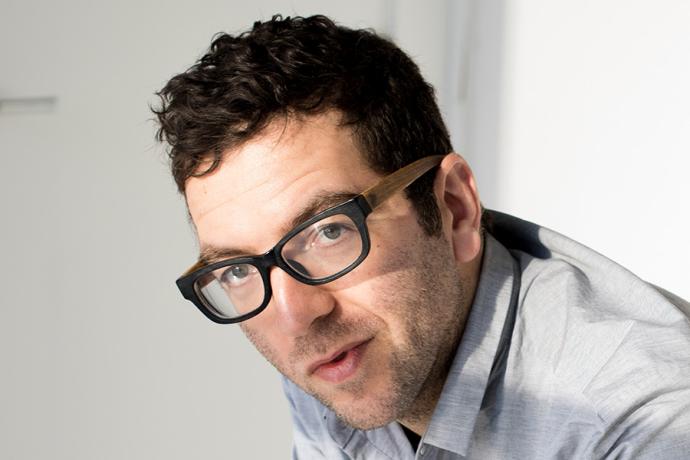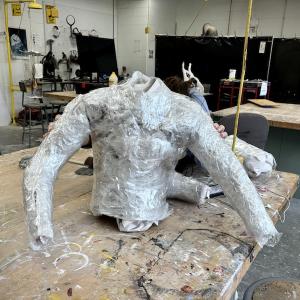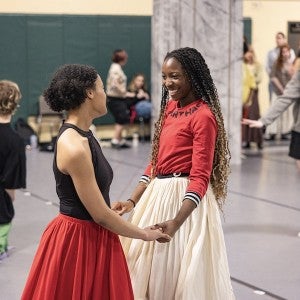The art of play
Game designer and NYU Game Center professor Eric Zimmerman shares how games can help us understand our rapidly evolving world—and how the core principles of game design benefit people in a variety of creative and technical fields.

Photo credit: Cris Moor.
In June 2020, Dear Reader became the first—and to date, only—video game ever reviewed by The New York Times Book Review. For many readers, the game’s inclusion in the highly esteemed literary section may have come as a surprise. But for Interlochen Arts Camp alumnus, game designer, and Dear Reader co-creator Eric Zimmerman (IAC/NMC 86-87), it was an affirmation of his belief in the beauty of games.
“My point of view is that games are an art form,” Zimmerman said in a recent interview with Crescendo. “For me, games stand shoulder-to-shoulder with dance, theatre, film, fine arts, and other forms of expression.”
Zimmerman is uniquely qualified to offer an argument—and a challenge—to the perennial 'are games art?’ debate: He studied visual arts at Interlochen Arts Camp and earned a B.F.A. in painting before entering the field of game design. Zimmerman has dedicated his 30-year career to studying the craft and relevance of games, training the next generation of game designers, and inventing new ways to play—including video games, tabletop games, and interactive art installations.
“One of the things that I think is interesting about games is that they combine all forms of expression,” Zimmerman said. “Games can have music; they can be performative; they include visual art; and they involve writing and storytelling, as well as social interaction and structural design.”
“They’re a little bit like opera: an artform in which visual, musical, and narrative forms of culture converge. Interlochen was great training for this kind of thinking.”
A playful past
Zimmerman’s passion for play is rooted in his youth, when he explored his creativity through both games and art.
“I had a childhood of enjoying different types of play: physical play, social play, playing on computers, and playing off computers,” Zimmerman said. “It was a very rich and varied cultural diet, which included neighborhood games such as Kick the Can and Ghosts in the Graveyard; tabletop games like Dungeons & Dragons; early computer games; and arcade games like Space Invaders and ‘Ms. Pac-Man.”
Zimmerman also studied fine arts, with a particular interest in painting. His artistic talents led him to Interlochen Arts Camp, where he spent his final two summers of high school as a visual arts major.
“I got so much out of the program,” Zimmerman said. “I was being taught by university professors and professional fine artists. I had the freedom to wander into one of the classrooms and just do work on my own whenever I wanted. On so many levels, it was a really incredible experience.”
Beyond their in-class lessons, Zimmerman’s Arts Camp instructors also curated extracurricular opportunities for their students to experience other forms of artistic expression.
“I was exposed to a lot of culture at Interlochen,” he said. “Some of the instructors would show films or play music for students—such as arthouse films, experimental black-and-white films, and Phillip Glass soundtracks. I was seeing and hearing these things while I was still in high school, and they had a really indelible impact on me.”
Creation and education
After Interlochen, Zimmerman earned a bachelor’s degree in painting before pursuing a career in game design. In 2000, he co-founded the independent game studio GameLab, which developed award-winning games including BLiX, Diner Dash, and Gamestar Mechanic.
Although Zimmerman’s early career centered on creating games, education has always been an important part of his work. He has taught game design at MIT, Parsons School of Design, and at workshops across the globe. In 2010, he became a founding faculty member of the NYU Tisch School of the Arts Game Center—a role that has since become his primary focus. His classes explore the theory behind games through hands-on exercises.
“My students think they’re in my class to learn technical skills, but what they actually do has a lot more to do with playground-style games and learning how to play physically,” Zimmerman said. “One of the things I love to do on the first day of class is to say, ‘Okay, we’re going to go outside and play some playground games.’ This gets students reconnecting with their bodies, laughing, and being goofy with each other.”
If you're not comfortable letting loose, how are you going to be creative? You learn about creativity through play. Loosening yourself up to explore systems playfully is a really important, basic human skill.
“That’s really important, because if you’re on a creative team in an office setting at some point in the future, and you’re not comfortable letting loose, how are you going to be creative?” Zimmerman continued. “All of these skills are wrapped up in each other. You learn about creativity through play. Loosening yourself up to explore systems playfully is a really important, basic human skill.”
Outside the classroom, Zimmerman maintains an active career as a game designer. He has created and collaborated on more than a dozen acclaimed games and installations over the course of his career, including browser-based game SiSSYFiGHT 2000 and tabletop game The Metagame.
“I’m still making games on the side, because my ‘research’ is my own creative practice,” he said. “I think that’s something I learned, in part, from Interlochen: The instructors there were people who not only taught art, but were artists themselves.”
Writing—and breaking—the rules
When Zimmerman began teaching game design, the field was just beginning to be studied and defined by scholars and educators. It was a stark contrast to Zimmerman’s experience as a visual arts student.
“Fine art is a field with all these ‘isms’—modernism, minimalism, expressionism—which are different styles and ways to approach who you are as an artist and how you fit into the historical context,” Zimmerman said. “There wasn’t that same kind of theoretical culture that breached the theory and practice of what people do when they create games.”
In 2003, Zimmerman and game designer, animator, and educator Katie Salen Tekinbaş published Rules of Play, which is widely regarded as one of the first and most influential textbooks on game design.
“It’s not an exaggeration to say that Katie and I were developing and exploring the critical language that would help us know what games are and how to talk about them,” Zimmerman said. “Writing Rules of Play was really about figuring out what games are, how to design them, and how to bridge the theory and practice of making games in the same way that I had as an artist.”
As Zimmerman continued to study, practice, and teach game design, he realized that the capacities he instills in his students are valuable for anyone living in the 21st century. In 2022, he published his second book, The Rules We Break, to bring these core skills to a larger audience.
“The Rules We Break is my way, as someone who has been teaching for decades, of trying to reach out beyond the field of game design,” Zimmerman said. “The exercises in the book are really relevant for people today—not just for people who want to be game creators, but for individuals working across a broad range of creative, technological, and other career fields.”
The design process is a problem-solving process. It’s really similar to art-making.
Zimmerman describes The Rules We Break as “a handbook for doing”—a unique volume that weaves thought-provoking essays with many of the same hands-on exercises Zimmerman uses in his game design classes and workshops. All of the exercises can be completed without a computer and can be played not only in a classroom setting, but also with friends and colleagues.
One of the book's exercises challenges participants to create a modified version of Tic Tac Toe.
“Tic Tac Toe is a game that we’ve all played, but most of us haven’t really analyzed it as a system,” Zimmerman said. “The exercise prompts you to think about things such as whether or not the game is fair, if it’s fun, what you like about it, and what you find boring about it, then experiment with ways to change the game and try to make it better. By looking at a simple game, you can start to practice things like systems analysis, the iterative design process, and communication.”
“The design process is a problem-solving process. It’s really similar to art-making.”
A window to the modern world
In today’s increasingly virtual world, Zimmerman believes it’s more important than ever to play games—and to understand the systems that govern them.
“My sense is that there’s a special relevance that games have to the times we’re living in today,” Zimmerman said. “So much of our art, media, and entertainment are mediated by networks of digital information. To be literate in today’s world means you have to know how to socialize, communicate, and engage with governments and organizations through those networks of information.”
Games and play create a situation that is intrinsically valuable–a situation that helps us understand who we are as people, how we relate to the world, and how we relate to each other. Games are fundamentally part of what it means to be human.
Zimmerman hopes his work will help games gain acceptance as meaningful facets of our artistic, educational, and cultural ecosystems.
“Part of what motivates me as a designer is that I feel that games and play should be a part of that landscape,” Zimmerman said. “No one questions that listening to, playing, or composing music is valuable. We don’t expect that everyone who learns music is going to become a musician, but we do know that music education teaches an aesthetic sensibility, connects you to previous cultures, teaches disciplines, helps you appreciate math and structure, and socializes you as you play with others.”
“Similarly, games and play create a situation that is intrinsically valuable: a situation that helps us understand who we are as people, how we relate to the world, and how we relate to each other,” Zimmerman continued. “Games are fundamentally part of what it means to be human.”




